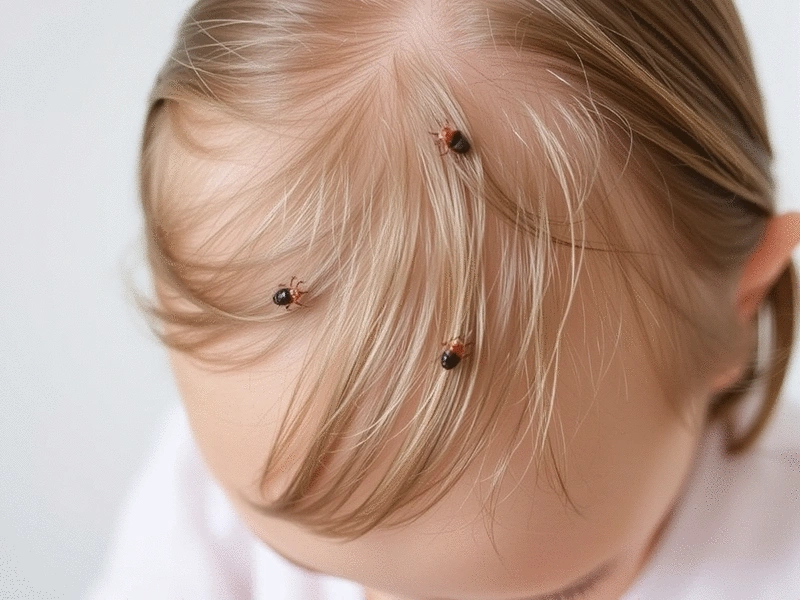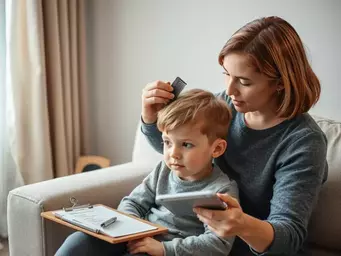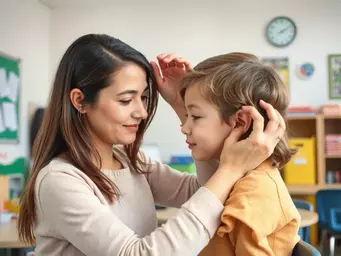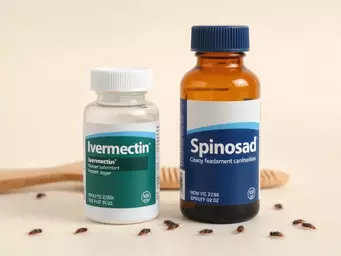Recognizing Head Lice in Children

What if I told you that the key to managing head lice effectively lies in early detection and education? Understanding the signs and facts about head lice can transform a potentially stressful situation into a manageable one. Let’s delve into the essential lessons that every parent should know!
What You Will Learn
- Early detection of head lice is crucial for preventing spread among siblings and classmates.
- Persistent itching and visible nits are primary symptoms to look for in head lice infestations.
- Understanding that head lice can only crawl and are not linked to hygiene helps alleviate common misconceptions.
- Knowing the lifecycle of head lice enables timely and effective treatment to eliminate them completely.
- Communicating with your child's school about lice infestations is key to managing outbreaks effectively.
Understanding the Head Lice Lifecycle & Key Identification Points
This visual illustrates the lifecycle of head lice and highlights critical areas for early detection, helping parents differentiate lice from dandruff and take timely action.
Head Lice Lifecycle: Stages & Duration
1. Egg (Nit)
Laid close to scalp
Hatch: 7-10 days
2. Nymph
Young louse
Grows to adult: 9-12 days
3. Adult Louse
Lays up to 6 eggs/day
Lives: ~30 days on scalp
Key Symptoms & Where to Look
-
•
Persistent Itching
-
•
Crawling Sensation
-
•
Irritated Spots
-
•
Behind the Ears
-
•
Nape of the Neck
Lice vs. Dandruff: Key Differences
Lice
Small, tan/gray, moving insects.
Nits (Eggs)
Tiny, oval, cling to hair shafts (yellow/white).
Dandruff
Flakes off easily, not attached to hair.
Understanding Head Lice: A Parent's Guide to Early Detection
Head lice are a common concern for many parents, especially those with school-aged children. The prevalence of head lice in schools and daycare centers can be alarming. Early detection is crucial, as it not only helps prevent the spread to other children but also reduces the stress that can come with an infestation. By being proactive, you can tackle head lice effectively and ensure your family feels supported during this challenge!
Did you know that head lice can affect children of all ages? It's essential to familiarize yourself with the signs and symptoms to catch them early. At Lice Nits, we understand the importance of empowering parents with reliable information so they can navigate these situations with confidence.
Why Identifying Head Lice is Crucial for Parents
Identifying head lice early can save you from a more extensive infestation later. The longer lice go untreated, the more they can spread. Here are some key reasons why early detection is essential:
- Preventing the spread to siblings and classmates.
- Avoiding the emotional distress related to lice infestations.
- Minimizing treatment time and costs.
Moreover, once you recognize the signs, you can take swift action to treat the infestation effectively. Remember, knowledge is power when it comes to your child's health!
Common Misconceptions About Head Lice
Many parents hold misconceptions about head lice that can lead to unnecessary panic. For example, some believe that lice can jump or fly. In reality, head lice can only crawl. Additionally, head lice have nothing to do with hygiene, as they can affect anyone, regardless of cleanliness. It’s important to understand these facts to alleviate fears and manage the situation calmly.
At Lice Nits, we aim to debunk these myths and provide you with accurate information to guide your decisions. Have you heard any myths about head lice that seem common? We'd love to hear your experiences!
Understanding Pediculosis: What Parents Should Know
Pediculosis refers to an infestation of lice, specifically the types that affect humans—primarily head lice. Understanding this term is essential for parents who want a comprehensive grasp of the situation. Pediculosis is more than just an annoyance; it can affect your child's comfort and social interactions. Knowing the facts can help you respond appropriately and swiftly to any signs of infestation.
By staying informed and educated, you’ll be better equipped to handle these situations, ensuring that your family is well-supported through the process.
Recognizing the Signs of Head Lice
Key Symptoms Parents Should Look For
One of the first signs of a head lice infestation is persistent itching. The itching is caused by an allergic reaction to the bites of the lice. In addition to itching, your child may experience:
- A crawling sensation on the scalp.
- Red, irritated spots on the scalp and neck.
- Irritability or scratching at the head more than usual.
If you notice any of these symptoms, it’s time to conduct a thorough inspection of your child’s hair. Early detection leads to quicker treatment, making it easier for everyone involved.
Where to Look for Head Lice and Nits
When checking for head lice, specific areas of the head are more likely to harbor these pests. Focus your search on:
- Behind the ears.
- The nape of the neck.
- The crown of the head.
Using a good light source can help you spot the lice and nits more easily. Don’t forget: nits (the eggs) are often found attached to the hair shafts. For more detailed guidance on identifying lice and nits, the American Academy of Pediatrics' HealthyChildren.org provides helpful information. If you see these, it’s a clear sign that lice are present!
Differentiating Lice and Nits from Dandruff
It's important to know how to differentiate lice and nits from other debris like dandruff. Here’s how:
- Lice are small, moving insects that can be tan or gray.
- Nits are tiny, oval-shaped eggs that cling to hair strands, often yellow or white.
- Dandruff, on the other hand, easily flakes off and is not attached to the hair.
Understanding these differences can help you identify an infestation more accurately and take the necessary steps towards treatment! The CDC offers comprehensive information on head lice identification, including how to distinguish them from other scalp conditions.
The Lifecycle of Head Lice: Understanding the Stages
To effectively manage head lice, it’s essential to understand their lifecycle. Lice go through three stages: egg (nit), nymph, and adult. Here's a brief overview:
- Egg (Nit): Laid close to the scalp, they hatch in about 7-10 days.
- Nymph: A young louse that grows into an adult within about 9-12 days.
- Adult: Capable of laying up to 6 eggs per day, adult lice can live for about 30 days on the scalp.
Understanding these stages helps in timing your treatments and ensuring that all lice and nits are eliminated effectively.
Frequently Asked Questions About Head Lice
- Q: What are the primary signs of a head lice infestation?
- A: The main signs include persistent itching, a crawling sensation on the scalp, red and irritated spots, and the presence of visible nits (eggs) attached to hair shafts.
- Q: Where should I look for head lice and nits?
- A: Focus your search on areas behind the ears, the nape of the neck, and the crown of the head. Nits are typically found firmly attached to hair strands close to the scalp.
- Q: How can I differentiate between head lice/nits and dandruff?
- A: Lice are small, moving insects (tan or gray). Nits are tiny, oval, yellow or white eggs that cling to hair shafts and are hard to remove. Dandruff consists of flakes that easily fall off the hair.
- Q: Is head lice infestation related to poor hygiene?
- A: No, head lice are not related to hygiene. They can affect anyone, regardless of how clean their hair or living environment is.
- Q: What is the lifecycle of a head louse?
- A: The lifecycle has three stages: egg (nit), nymph, and adult. Nits hatch in 7-10 days, nymphs grow into adults in 9-12 days, and adult lice live for about 30 days and can lay multiple eggs daily.
- Q: What should I do if my child has head lice?
- A: Check all household members, inform your child's school, begin treatment promptly with appropriate remedies, and clean bedding, clothing, and hair accessories in hot water.
We Want to Hear From You!
Have you encountered any unique challenges while dealing with head lice? Share your experiences or tips with us below:
Recap of Key Signs and Symptoms of Head Lice
As parents, it’s essential to stay vigilant and informed about the signs of head lice. Remember, early detection can significantly reduce the stress of an infestation. Here are the key signs to look out for:
- Persistent itching: This is often the first noticeable symptom, caused by an allergic reaction to lice bites.
- Crawling sensations: Children may complain that their scalp feels like something is crawling.
- Irritability: Increased fussiness may occur, especially in younger children.
- Visible nits: Small white eggs attached to hair shafts, often near the scalp.
By being aware of these signs, you can act swiftly to prevent the spread of lice within your household. Keeping a checklist handy can help you remember what to look for during your regular inspections!
Taking Action: What to Do If You Find Head Lice
Finding head lice can feel overwhelming, but quick action is essential! If you discover lice, I encourage you to take the following steps immediately:
- Check all household members, as lice spread easily.
- Communicate with your child's school to inform them of the situation.
- Begin treatment as soon as possible, using either over-the-counter or natural remedies.
- Wash bedding, clothing, and hair accessories in hot water to eliminate any lingering lice.
Taking these steps not only helps manage the current situation but also aids in preventing further infestations. You’re not alone in this, so reach out to friends or family for support during this challenging time!
Accessing Resources for Further Support
When dealing with head lice, having access to reliable resources can make a world of difference. Here are some valuable materials you can explore:
- CDC Head Lice Information - Comprehensive guidelines on prevention and treatment.
- NHS Advice on Head Lice - Helpful insights and FAQs.
- Your local health department - They often provide free resources and support.
- Community support groups: Online forums can offer personal experiences and advice.
These resources can empower you with the knowledge needed to tackle lice effectively. At Lice Nits, we’re here to provide any additional guidance you may require!
Addressing Emotional Support for Children
Talking about head lice can make children anxious, but it’s crucial to approach the topic gently. Here are some tips to help ease their worries:
- Explain that head lice are common and not a reflection of cleanliness.
- Reassure them that lice can be treated effectively and that they will be okay.
- Involve them in the treatment process to give them a sense of control.
- Encourage open communication; let them express their feelings about it.
By addressing their concerns, you can help alleviate the stigma associated with lice. Remember, many children experience this, and it’s okay to talk about it!
Understanding School Policies on Head Lice Management
Each school has its own policy regarding head lice, but many emphasize the importance of communication. For example, the California Department of Public Health offers guidance for schools on head lice management. Here are some points to keep in mind:
- Notify the school nurse if your child is found to have lice.
- Understand the school’s guidelines on how they handle lice outbreaks.
- Be proactive in keeping your child’s school informed about any reoccurrences.
- Encourage awareness among parents through school newsletters or meetings.
Being in sync with your child’s school can help manage outbreaks more effectively. Together, we can work towards a lice-free environment for our kids! Don’t hesitate to reach out with questions or concerns; we’re all in this together!
Recap of Key Points
Here is a quick recap of the important points discussed in the article:
- Early Detection: Identifying head lice early helps prevent the spread and reduces emotional distress.
- Common Symptoms: Look for persistent itching, crawling sensations, irritability, and visible nits.
- Inspection Areas: Focus on checking behind the ears, the nape of the neck, and the crown of the head.
- Lifecycle Awareness: Understanding the stages of lice (nit, nymph, adult) aids in effective treatment timing.
- Emotional Support: Address children's concerns gently and involve them in the treatment process to alleviate anxiety.
- School Communication: Notify the school about any lice findings and stay updated on their management policies.
Popular Posts
 Have you ever felt the panic that arises when you discover head lice on your child's scalp? Understa
Have you ever felt the panic that arises when you discover head lice on your child's scalp? Understa
 It's surprising how easily something as small as a head louse can disrupt an entire school community
It's surprising how easily something as small as a head louse can disrupt an entire school community
 What if the key to your child's comfort and well-being lies in understanding the aftercare process f
What if the key to your child's comfort and well-being lies in understanding the aftercare process f
 What if a single application could free your family from the stress of head lice? One-dose treatment
What if a single application could free your family from the stress of head lice? One-dose treatment
